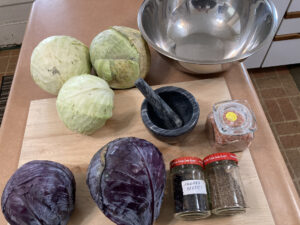



The second of three 30 pound boxes of veggies from Roxbury Farm in Kinderhook (Columbia County), New York, included in a winter farm share, is due for delivery during the first week of the new year 2023. The first 30 pound box, received during the first week of December 2022, included only 2 heads of cabbage, one red and one green (along with 39 carrots, 22 red beets, 22 white potatoes, 14 watermelon radishes, 9 onions, 4 huge sweet potatoes, 3 celeriac, 2 butternut squashes, and a cup of popcorn kernels).
But with heads of cabbage also included in the 2022 Roxbury Farm CSA weekly farm share of 24 weeks (which began in early June and ended in early November), I counted five cabbages in the fridge, 3 green and 2 red. And with more cabbages likely on the way from the farm, it was clearly time to make more sauerkraut.
Five years ago, we first shared an easy-to-make recipe from Fermentation on Wheels, Road Stories, Food Ramblings, And 50 Do-It-Yourself Recipes by Tara Whitsitt, who has been called the “Johnny Appleseed of Pickling.” It’s a recipe that is fun to make and therapeutic. Massaging chopped cabbage with salt, juniper berries and caraway seeds for 15 minutes is a tactile and satisfying activity. In our review of Kristin Kimball’s Good Husbandry: Growing Food, Love, and Family on Essex Farm, we spotlighted how Kristin Kimball “clearly revels in one aspect of farm life: the food.” She takes joy in the making of maple syrup and huge amounts of sauerkraut!
Why is it a good idea to include sauerkraut in your diet? It’s been 10 years since we’ve reviewed Michael Pollan’s Food Rules and noted his Rule 36, “Eat some foods that have been predigested by bacteria or fungi.” In Pollan’s words: fermented foods, such as yogurt, sauerkraut, soy sauce, kimchi, and sourdough bread, “have been transformed by live microorganisms” and “can be a good source of vitamin B12 . . . and probiotics which improve the function of the digestive and immune systems and . . . may help reduce allergic reactions and inflammation.”
In our review of The Hidden Half Of Nature, The Microbial Roots Of Life And Health by David R. Montgomery and Anne Biklé, we shared the almost incomprehensible news that there are some 1030 microbes on Earth – that’s a nonillion of them – and they’re everywhere, including deep within us. And we noted that microbes should be our friends, with our health maintained through a microbes-driven balancing act.
Instead, we are a nation in far poorer health than we were even a half-century ago: By feeding ourselves food that has been processed to an unhealthy degree, or eating food grown in such poor soil that it’s devoid of beneficial microbes and micronutrients – copper, magnesium, iron, and zinc.
A few years ago, we cited an article in Bostonia (Winter-Spring 2018), Gut Check, Researchers test the probiotics in food and supplements by Kate Becker, focused on answering the question whether manufactured supplements available in pharmacies and many supermarkets actually contain what the labels promise, and how they compare to fermented foods, which are also teeming with microbes. The Boston University researchers determined that there were living bacteria in the manufactured supplements, but fermented food samples, which were tested for comparison, had more variety.
According to my well-thumbed copy of Edible An Illustrated Guide to the World’s Food Plants (Washington, D.C.: National Geographic Society, 2008), the cabbage was the first member of the Brassicaceae family to have been cultivated, valued as a food plant by the Ancient Egyptians and the Greeks, with headed cabbages, first mentioned as early as the first century CE, “are thought to have developed in Germany around the twelfth centruy, then spread over Europe.” Cabbage was first taken to North America in the sixteenth century.
Gratitude in the 21st century to Roxbury Farm for growing this healthful food for my household!
(Frank W. Barrie, 12/30/22)





